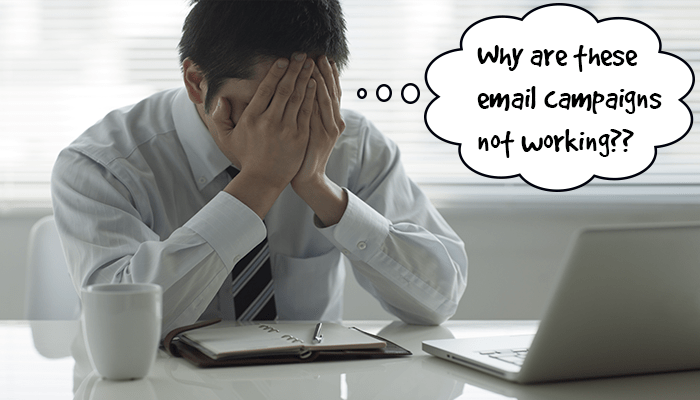
If you’ve noticed that your email marketing efforts have seen a decline in engagement amongst recipients in recent times, you’re certainly not alone.
There’s no doubt that the digital medium has become saturated; a dizzying 2.4 million emails are sent every second, leaving users feeling bombarded and overwhelmed. Where we were once happy to receive messages containing potentially attractive offers, we are now more likely to get a buzz out of an empty inbox.
The statistics illustrate this point nicely; although (perhaps surprisingly), open rates continue to see a steady increase, click rates have been declining in recent years — take a look at the graph below showing data collected by Epsilon for proof.

However, though this may seem disheartening at first, marketers and business owners would be incredibly foolish to write email marketing off. On the contrary, when done effectively it is by far the most successful tactic in terms of both engagement and driving sales. Email marketing generates $38 for every $1 spent, according to Campaign Monitor, and it also has the highest conversion rate (66%) when compared to social, direct mail and other forms of marketing message, as notes the Direct Marketing Association.
Clearly, it is well worthwhile for marketers to focus their attentions on improving email campaigns as opposed to abandoning them, so what are the possible reasons behind their failure, and what can be done to turn the situation around?
The Problem: Emails Aren’t Getting Opened
Your first port of call when it comes to determining what is causing low rates of engagement should always be your analytics. If you do find that your messages are falling at the first hurdle and simply aren’t being opened, there could be a few factors at play. One important thing to bear in mind is that the average open rate varies a fair amount depending on the industry that your business is in, as is shown in this table from Smart Insights.

The Solution: Catchy Subject Lines, Send Messages Sparingly
Effective subject lines are vital to ensuring your emails pass the very first test and actually get opened. Some tips to do this include:
- The Personal Touch – According to Experian, emails with personalised subject lines have a 26% greater chance of being opened.
- Know Your Audience – Research from Marketing Land found that people aged 45 and over (nearly 70%) were more receptive to humour in subject lines than a younger audience – proof that it is important to have a good understanding of your client base.
- Experiment – It’s always worth testing out different types of subject lines and keeping a record of which worked best for your audience. Does length have an effect? Do certain words work better than others? How familiar should your tone be?
- Resend – A good way to give your emails another chance of getting read with minimal work involved is to simply resend them again a week or so later, but just to those who didn’t open it the first time – you only need to alter the subject line and it’s ready to go!
It’s also important to limit your monthly communications. Research suggests that recipients look at the sender of the mail before anything else, so if you are showing up very frequently in their inbox they will soon notice and may take action to avoid any more messages from you.
The Problem: Emails Bouncing
Discovering that your email campaigns have a high bounce rate should be a cause for concern for two reasons. Firstly, it means that a large number of your messages simply aren’t getting read, which is obviously pretty counterproductive for any marketing activity. Secondly, a high bounce rate could potentially mean your overall deliverability rate is negatively affected if ISPs identify you as a spammer, therefore having a knock-on effect for future campaigns. For the average hard bounce rate in your region, take a look at the chart below.

The Solution: Clean Data, Relevant Content, No Spam-Like Behaviour
Fortunately, as long as you stick to best practices and put enough care into the design of your email campaign, it isn’t too difficult to avoid a high number of bounces. In doing so you should remember to:
- Practice Good List Hygiene – You can do this by regularly clearing out invalid email addresses, and ensuring that your current contact data is error-free and up to date. You could use our highly accurate B2B intelligence at Global Database to validate the accuracy of your own mailing lists.
- Don’t Act Like a Spammer – Avoid any behaviour that could see you identified as a spammer by ISPs. This means not using words like ‘free’, ‘prize’ or ‘opportunity’ in subject lines, avoiding excessive capitalisation and unusual fonts, and not sending out mail using free email accounts.
- Make Your Messages Valuable – Because most mail servers and ISPs use community-based systems to identify spammers, it is crucial that your email recipients see your content as valuable. Make it relevant to their needs and interests and avoid going in for the hard-sell.
- Provide an Unsubscribe Option – This is not only essential in order to comply with CAN-SPAM regulations, it also means that any recipients who aren’t engaging with your emails can simply request to stop receiving them, instead of becoming frustrated and labelling your messages as spam.
The Problem: Low Engagement Levels
Knowing how many conversions to expect from each email campaign can be tricky, but if your engagement levels are lower than you had hoped for you’ll obviously want to identify the problem and adapt your next campaign accordingly. Ultimately this will probably take a bit of trial and error, as you tweak different factors along the way, but it is definitely worth putting the time and effort into doing a thorough job.
The Solution: A Whole Heap of Possibilities!
There are a number of different fixes to try in order to improve the engagement levels of your campaigns. This could include:
- Personalisation and Segmentation – Creating personalised emails no longer means simply using the recipient’s name; instead you should aim to always provide content that is relevant to your customers’ needs. Doing so certainly pays off; the Direct Marketing Association notes that 77% of ROI comes from segmented, targeted and triggered campaigns. Segment your contact lists depending on their level of interest in your company, and how much they have engaged with your brand so far. You could also use a B2B intelligence provider such as us here at Global Database in order to qualify leads and segment them that way, based on specifics such as company revenue, location and employee numbers.
- Retargeting – Don’t give up on leads that fail to complete a purchase on your site; according to Experian ecommerce customers who received multiple abandoned shopping cart emails are 2.4 times more likely to complete the purchase than those who receive only one follow up email.
- Effective CTA – Having a clear and appealing call to action in your emails is essential; WordStream found that emails with a single call-to-action increased clicks 371% and sales 1617%. Including a button instead of a link is usually a good idea to boost clicks – by as much as 45% according to CreateDebate.
- Double Opt-Ins – Asking leads to complete a two-step process in order to subscribe may seem like an undesirable exercise, but ultimately it means that those who do sign up are likely to be genuinely interested in your company and therefore make for easier conversions.
- Optimise for Mobile – According to research conducted by Litmus, 55% of email opens now occur on mobile devices, with iPhone opens in particular seeing a big increase, as is shown in the chart below, taken from Litmus’ 2016 State of Email report. With this in mind it is vital that your emails are optimised for mobile devices. Make sure that your layout works, don’t include too many graphics/images and use buttons large enough for touch-screens.

Fixing failing email campaigns can take some time, but by committing to best practices and learning what works best for your business, you should start to see results. If you do find that you’re still not getting the levels of engagement that you would like, or simply need immediate access to a whole new set of contacts for your next campaign, Global Database has you covered.
Our innovative online platform holds millions of records for organisations and individuals worldwide, across a total of 34 industries. Whatever sector you are looking to target, you’ll find plenty of high quality leads to add to the top of your sales funnel, all with direct contact details to ensure you can start selling to the right people straight away.


![15 Best Affiliate Recruitment Software Tools [2025 Update] - 15 Best Affiliate Recruitment Software Tools [2025 Update] -](https://www.toptut.com/wp-content/uploads/2024/01/affiliate-recruitment-software-1.png)






